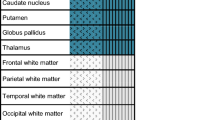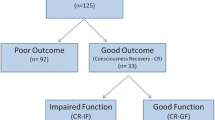Abstract
Objective
We examined whether early diffusion-weighted magnetic resonance imaging (DW-MRI) abnormalities of the brain and variation of apparent diffusion coefficient (ADC) values can provide prognostic information on clinical outcome in children following cardiac arrest (CA).
Design
Retrospective study.
Setting
A 12-bed paediatric intensive care unit (PICU).
Patients
Children aged between 1 month and 18 years who had DW-MRI with ADC measurement within the first week following CA. Neurological outcomes were assessed using the Pediatric Cerebral Performance Category Scale (PCPC). Differences between the favourable (PCPC ≤3) and unfavourable (PCPC ≥4) groups were analysed with regard to clinical data, electrophysiological patterns as well as qualitative and quantitative DW-MRI abnormalities.
Results
Twenty children with a median age of 20 months (1.5–185) and a male/female sex ratio of 1.5 underwent DW-MRI after CA with a median delay of 3 days (1–7). Aetiologies of CA were (i) asphyxia (n = 10), (ii) haemodynamic (n = 5) or (iii) unknown (n = 5). With regard to DW-MRI findings, the unfavourable outcome group (n = 8) was associated with cerebral cortex (p = 0.02) and basal ganglia (p = 0.005) lesions, with a larger number of injured brain regions (p = 0.001) and a global decrease in measured ADC signal (p = 0.008). Normal DW-MRI (n = 5) was exclusively associated with the favourable outcome group (n = 12).
Conclusion
Qualitative, topographic and quantitative analysis of early DW-MRI with ADC measurement in children following CA may provide valuable prognostic information on neurological outcomes.

Similar content being viewed by others
References
Topjian AA, Berg RA, Nadkarni VM (2008) Pediatric cardiopulmonary resuscitation: advances in science, techniques, and outcomes. Pediatrics 122(5):1086–1098
Atkins DL, Everson-Stewart S, Sears GK, Daya M, Osmond MH, Warden CR et al (2009) Epidemiology and outcomes from out-of-hospital cardiac arrest in children: the Resuscitation Outcomes Consortium Epistry-Cardiac Arrest. Circulation 119(11):1484–1491
Young KD, Gausche-Hill M, McClung CD, Lewis RJ (2004) A prospective, population-based study of the epidemiology and outcome of out-of-hospital pediatric cardiopulmonary arrest. Pediatrics 114(1):157–164
Donoghue AJ, Nadkarni V, Berg RA, Osmond MH, Wells G, Nesbitt L et al (2005) Out-of-hospital pediatric cardiac arrest: an epidemiologic review and assessment of current knowledge. Ann Emerg Med 46(6):512–522
Moler FW, Meert K, Donaldson AE, Nadkarni V, Brilli RJ, Dalton HJ et al (2009) In-hospital versus out-of-hospital pediatric cardiac arrest: a multicenter cohort study. Crit Care Med 37(7):2259–2267
Young KD, Seidel JS (1999) Pediatric cardiopulmonary resuscitation: a collective review. Ann Emerg Med 33:195–205
Nadkarni VM, Larkin GL, Peberdy MA et al (2006) First documented rhythm and clinical outcome from in-hospital cardiac arrest among children and adults. JAMA 295:50–57
Abend NS, Licht DJ (2008) Predicting outcome in children with hypoxic ischemic encephalopathy. Pediatr Crit Care Med 9(1):32–39
Mandel R, Martinot A, Delepoulle F, Lamblin M, Laureau E, Vallee L et al (2002) Prediction of outcome after hypoxic-ischemic encephalopathy: a prospective clinical and electrophysiologic study. J Pediatr 141(1):45–50
Wijdicks EFM, Hijdra A, Young GB, Bassetti CL, Wiebe S (2006) Practice parameter: prediction of outcome in comatose survivors after cardiopulmonary resuscitation (an evidence-based review): report of the Quality Standards Subcommittee of the American Academy of Neurology. Neurology 67(2):203–210
Carrai R, Grippo A, Lori S, Pinto F, Amantini A (2010) Prognostic value of somatosensory evoked potentials in comatose children: a systematic literature review. Intensive Care Med 36:1112–1126
Arbelaez A, Castillo M, Mukherji SK (1999) Diffusion-weighted MR imaging of global cerebral anoxia. AJNR Am J Neuroradiol 20(6):999–1007
Rojas S, Martín A, Justicia C, Falcón C, Bargalló N, Chamorro A et al (2006) Modest MRI signal intensity changes precede delayed cortical necrosis after transient focal ischemia in the rat. Stroke 37(6):1525–1532
Oppenheim C, Grandin C, Samson Y, Smith A, Duprez T, Marsault C et al (2001) Is there an apparent diffusion coefficient threshold in predicting tissue viability in hyperacute stroke? Stroke 32(11):2486–2491
Desmond PM, Lovell AC, Rawlinson AA, Parsons MW, Barber PA, Yang Q et al (2001) The value of apparent diffusion coefficient maps in early cerebral ischemia. AJNR Am J Neuroradiol 22(7):1260–1267
Weiss N, Galanaud D, Carpentier A, Naccache L, Puybasset L (2007) Clinical review: prognostic value of magnetic resonance imaging in acute brain injury and coma. Crit Care 11(5):230
Gutierrez LG, Rovira A, Portela LA, Leite Cda C, Lucato LT (2010) CT and MR in non-neonatal hypoxic-ischemic encephalopathy: radiological findings with pathophysiological correlations. Neuroradiology 52(11):949–976
Wijman CAC, Mlynash M, Caulfield AF, Hsia AW, Eyngorn I, Bammer R et al (2009) Prognostic value of brain diffusion-weighted imaging after cardiac arrest. Ann Neurol 65(4):394–402
Choi SP, Park KN, Park HK, Kim JY, Youn CS, Ahn KJ et al (2010) Diffusion-weighted magnetic resonance imaging for predicting the clinical outcome of comatose survivors after cardiac arrest: a cohort study. Crit Care 14(1):R17
Rutherford M, Counsell S, Allsop J, Boardman J, Kapellou O, Larkman D et al (2004) Diffusion-weighted magnetic resonance imaging in term perinatal brain injury: a comparison with site of lesion and time from birth. Pediatrics 114(4):1004–1014
Alderliesten T, de Vries LS, Benders MJ, Koopman C, Groenendaal F (2011) MR imaging and outcome of term neonates with perinatal asphyxia: value of diffusion-weighted MR imaging and 1H MR spectroscopy. Radiology 261(1):235–242
Van Laerhoven H, de Haan TR, Offringa M, Post B, van der Lee JH (2013) Prognostic tests in term neonates with hypoxic-ischemic encephalopathy: a systematic review. Pediatrics 131(1):88–98
Liauw L, van Wezel-Meijler G, Veen S, van Buchem MA, van der Grond J (2009) Do apparent diffusion coefficient measurements predict outcome in children with neonatal hypoxic-ischemic encephalopathy? AJNR Am J Neuroradiol 30(2):264–270
Barkovich AJ (1992) MR and CT evaluation of profound neonatal and infantile asphyxia. AJNR Am J Neuroradiol 13(3):959–972 discussion 973–975
Cervos-Navarro J, Diemer NH (1991) Selective vulnerability in brain hypoxia. Crit Rev Neurobiol 6:149–182
Huang BY, Castillo M (2008) Hypoxic-ischemic brain injury: imaging findings from birth to adulthood. Radiographics 28:417–439
Christophe C, Fonteyne C, Ziereisen F, Christiaens F, Deltenre P, De Maertelaer V et al (2002) Value of MR imaging of the brain in children with hypoxic coma. AJNR Am J Neuroradiol 23:716–723
Dubowitz DJ, Bluml S, Arcinue E, Dietrich RB (1998) MR of hypoxicencephalopathy in children after near drowning: correlation with quantitative proton MR spectroscopy and clinical outcome. AJNR Am J Neuroradiol 19:1617–1627
Fink EL, Panigrahy A, Clark RS, Fitz CR, Landsittel D, Kochanek PM et al (2012) Regional brain injury on conventional and diffusion weighted MRI is associated with outcome after pediatric cardiac arrest. Neurocrit Care Apr 26 [Epub ahead of print]
Biarent D, Bingham R, Richmond S, Maconochie I, Wyllie J, Simpson S et al (2005) European Resuscitation Council. European Resuscitation Council guidelines for resuscitation 2005. Section 6. Paediatric life support. Resuscitation 67(1):S97–S133
Biarent D, Bingham R, Eich C, López-Herce J, Maconochie I, Rodríguez-Núñez A et al (2010) European Resuscitation Council guidelines for resuscitation 2010. Section 6. Paediatric life support. Resuscitation 81(10):1364–1388
Tasker RC, Boyd S, Harden A, Matthew DJ (1988) Monitoring in non-traumatic coma. Part II: electroencephalography. Arch Dis Child 63(8):895–899
Fiser DH (1992) Assessing the outcome of pediatric intensive care. J Pediatr 121(1):68–74
Fiser DH, Long N, Roberson PK, Hefley G, Zolten K, Brodie-Fowler M (2000) Relationship of pediatric overall performance category and pediatric cerebral performance category scores at pediatric intensive care unit discharge with outcome measures collected at hospital discharge and 1- and 6-month follow-up assessments. Crit Care Med 28(7):2616–2620
Ebisu T, Naruse S, Horikawa Y, Ueda S, Tanaka C, Uto M et al (1993) Discrimination between different types of white matter edema with diffusion-weighted MR imaging. J Magn Reson Imaging 3:863–868
Wu O, Sorensen AG, Benner T, Singhal AB, Furie KL, Greer DM (2009) Comatose patients with cardiac arrest: predicting clinical outcome with diffusion-weighted MR imaging. Radiology 252(1):173–181
Forder JP, Tymianski M (2009) Postsynaptic mechanisms of excitotoxicity: involvement of postsynaptic density proteins, radicals, and oxidant molecules. Neuroscience 158:293–300
Ye H, Jalini S, Zhang L, Charlton M, Carlen PL (2010) Early ischemia enhances action potential-dependent, spontaneous glutamatergic responses in CA1 neurons. J Cereb Blood Flow Metab 30:555–565
Nguyen V, McQuillen PS (2010) AMPA and metabotropic excitoxicity explain subplate neuron vulnerability. Neurobiol Dis 37:195–207
Guerguerian AM, Brambrink AM, Traystman RJ, Huganir RL, Martin LJ (2002) Altered expression and phosphorylation of N-methyl-D-aspartate receptors in piglet striatum after hypoxia–ischemia. Brain Res Mol Brain Res 104:66–80
Le Bihan D, Poupon C, Amadon A, Lethimonnier F (2006) Artifacts and pitfalls in diffusion MRI. J Magn Reson Imaging 24:478–488
Kawahara H, Takeda Y, Tanaka A, Nagano O, Katayama H, Hirakawa M et al (2000) Does diffusion-weighted magnetic resonance imaging enable detection of early ischemic change following transient cerebral ischemia? J Neurol Sci 181(1–2):73–81
Els T, Kassubek J, Kubalek R, Klisch J (2004) Diffusion-weighted MRI during early global cerebral hypoxia: a predictor for clinical outcome? Acta Neurol Scand 110(6):361–367
Lövblad KO, Wetzel SG, Somon T, Wilhelm K, Mehdizade A, Kelekis A et al (2004) Diffusion-weighted MRI in cortical ischaemia. Neuroradiology 46(3):175–182
Author information
Authors and Affiliations
Corresponding author
Electronic supplementary material
Below is the link to the electronic supplementary material.
Rights and permissions
About this article
Cite this article
Oualha, M., Gatterre, P., Boddaert, N. et al. Early diffusion-weighted magnetic resonance imaging in children after cardiac arrest may provide valuable prognostic information on clinical outcome. Intensive Care Med 39, 1306–1312 (2013). https://doi.org/10.1007/s00134-013-2930-z
Received:
Accepted:
Published:
Issue Date:
DOI: https://doi.org/10.1007/s00134-013-2930-z




